 |
|
 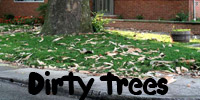  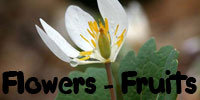 |
Welcome
to bobklips.com, the website of Bob Klips, a plant enthusiast living in
Columbus, Ohio. (Additional content at flickr Photostream and YouTube Channel) If you have botany questions or comments please email BobK . Thanks! |
| Lichens
and Mosses and
Sedges (Oh My!) Deep Woods Preserve Hocking County, Ohio. May 31, 2010 The weather seemed just right
--calm, and slightly overcast --for hunting lichens and capturing their
images at Deep Woods, a privately owned nature preserve in Hocking
County, Ohio. One of the best lichen substrates is tree bark. A large
lateral branch of ironwood is fairly covered with a foliose lichen
that, being brown and having quite narrow lobes, was suspected,
correctly as it turns out, to be a "shadow lichen" (genus Phaeophyscia) that was later determined, by its possession of an orange
medula (inner portion), to be orange-cored shadow lichen, P. rubropulchra.
Growing plunk in the middle of the lichen-patch is an as-yet unidentified species of Orthotrichum moss. The genus is distinctive, consisting of small tufted acrocarps (cushion mosses) with leaves that are straight, not contorted, and the sporophytes of which are short-stalked, with the sporangia (capsules) barely emergent from the subtending leaves. The peristome consists of 8 or 16 teeth that are strongly reflexed when the moss is wet. Orthotrichum is apparently one of the few mosses that disperse spores under damp, not dry, conditions. MOUSEOVER the IMAGE
for ZOOM-CROP of MOSS
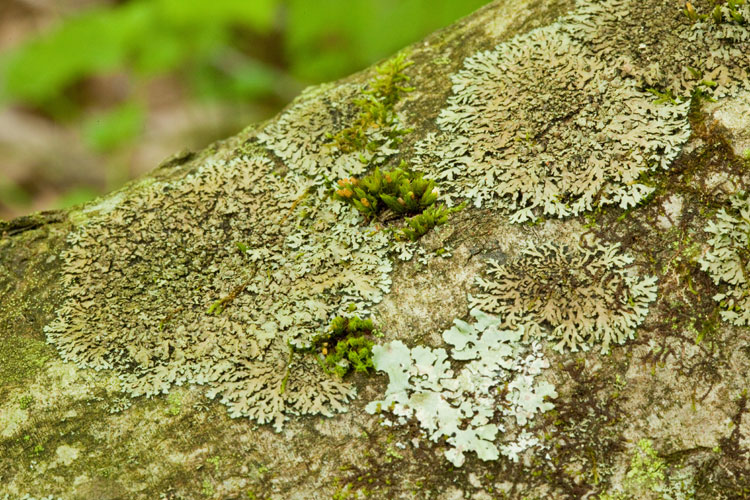 Lichens and moss on Carpinus branch. Deep Woods. May 31, 2010. The larger-lobed, gray
foliose lichen in the foreground may be a very common but challenging
one to identify, powdery axil-bristle lichen, Myelochroa aurulenta.
Like the shadow-lichen it is growing with, this is known to be rather
shade-tolerant. It is supposed to be distinguished by the presence of
numerous pustules of coarse soredia, but thay are often lacking. It is
also said to have a yellowish medula, but descriptions also mention
the medula may be white, with the yellow confined to the area beneath
the non-existent soralia. As for the eponymous bristles in the lobe
axils, they too can be entirely lacking and, to make matters worse,
pose a challenge for a mortal lichen neopyte trying to distinguish
lobe-axil bristles from rhizines that are numerous and extend to the
lobe tips. As they say in Brooklyn, "fuhgeddaboudit!!"
Here's another possible instance of fuhgeddaboudit lichen, Myelochroa aurulenta (or not) growing high on the bark of a hardwood tree. It's mixed in with a distinctively slender pleuorcarp (carpet moss) moss Haplohymenium triste (Leskeaceae). 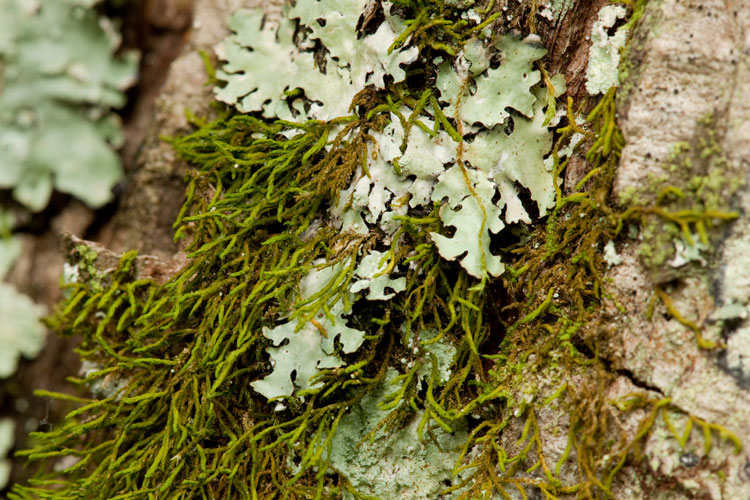 Haplohymenium triste moss with fuhgeddaboudit lichen at Deep Woods. May 31, 2010. Haplohymenium triste, like most
other genera in the Leskeaceae (i.e., Anomodon,
Leskea, Thelia) has leaves with cells that are bumpy
(papillose). The gametophytes grow in thin mats; the genus closely
resembles an Anomodon,
from which is is distinguished microscopically by the leaves narowed
from a broad tongue-shaped base, many with their tips broken off. The
specific epithet triste means
"sad."
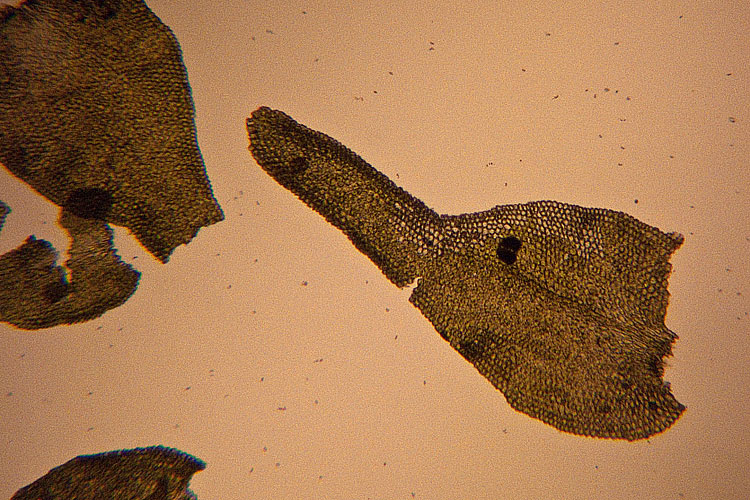 Haplohymenium triste leaves, microscope view. Note fragile tips. Along the notorious Marathon
pipeline corridor scooting through this area is a tree stump that seems
to be Club Cladonia.
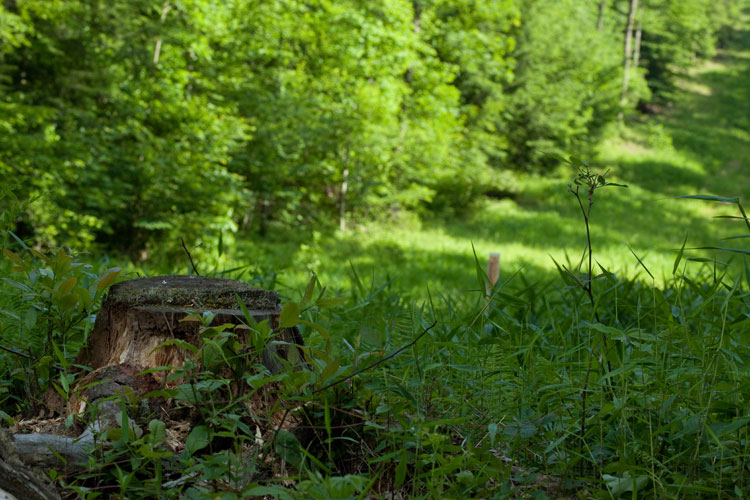 Tree stump where several Cladonia lichens grow. May 31, 2010. Deep Woods. Unfortunately
I haven't studied these guys enough to put names on them (You could say
I'm stumped!), but it seems there are four different ones here. The
photo below shows: (1) in lower right, a specimen with short podetia
each topped by a large dark brown apothecium; (2) upper left, a taller
one tipped with quite small pale brown apothecia.
 A cladonia convention on a stump at Deep Woods. May 31, 2010. ...while
here we seem to have, on the left: (3) the beginning of the
establishment of some type of reindeer lichen, and (4) finally a
recognizable one, the "British soldier" lichen, Cladonia cristatella.
 Cladonia cafe at Deep Woods. May 31, 2010. Nearby, in a meadow,
something
common and uncommon at the same time. This is Cladonia furcata,
a fairly common non-reindeer lichen that is nonetheless quite branched.
This is distinguished from a reindeer lichens by the fact that there
are a few squamules on the podetia; these are entirely absent from
reindeer lichens. What's unusual here is the fact that this specimen is
bearing apothecia.
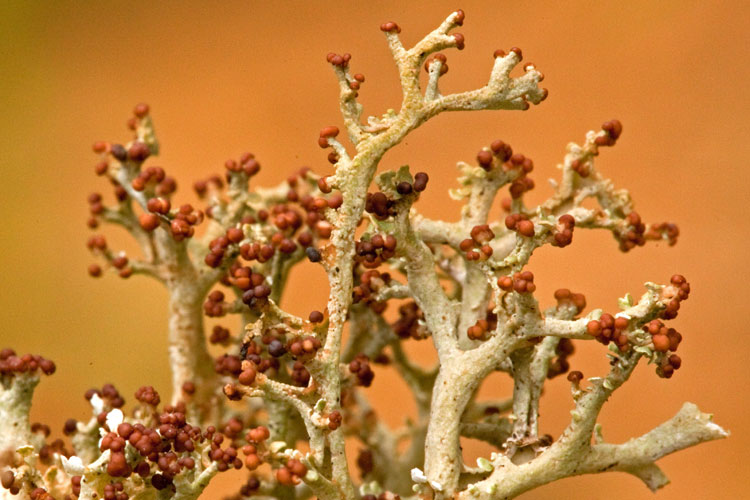 Cladonia furcata with apothecia. Woot! Several sedges in the genus Carex
are growing side-by-side in a moist meadow. They hail from different
sections of the genus, distinguished in part by the positions of
pistillate and staminate flowers relative to each other. Carex flowers
are unisexual, with both types on a single plant, i.e., the plants are
monoecious. Also pertienent is whether the
spikelets (flower clusters) are sessile as opposed to being stalked,
if there is a simple spike-like flower cluster or instead a
compound panicle, and also the shape of the
achene: is it trigonous and with three styles, or biconvex and
with two styles?
The only species in section Shortiana is restricted to the interior of eastern North America. It's Short's sedge, Carex shortiana, a denizen of swampy woods and thickets, and wet open meadows and prairie swales. As T. Cochrane aptly states in v. 23 of Flora of North America (the sedge volume, a masterpiece), "It is notable among our tristigmatic carices in having all the spikes gynecaandrous, the lateral ones repeating the pattern of the terminal spike." "Gynecandrous" means having the female flowers above (distal to) the male ones. 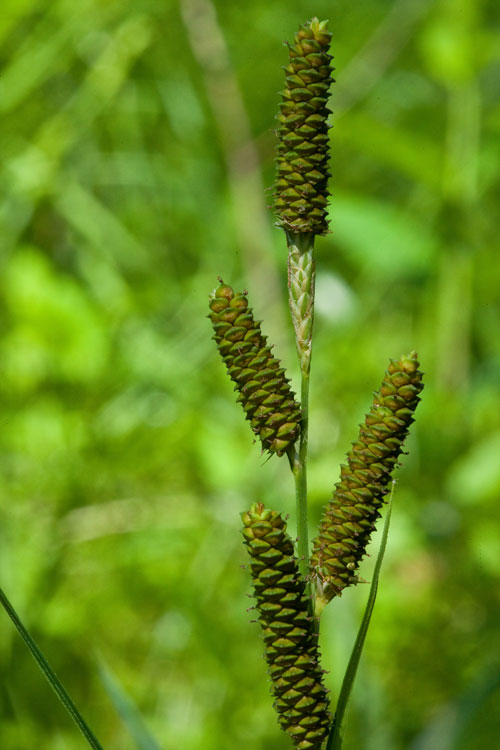 Short's sedge at Deep Woods. May 31, 2010. In the fairly large section
Granulares, we see Carex granularis.
The terminal
spike is entirely staminate and sessile, while the pistillate spikes
are dense. The perigynia bag-like envelope
surrounding the one-seeded fruit) are essentially globose and very
short-beaked. E. Lucy
Braun describes the habitat of C.
granularis as "Wide ranging, in moist
woods, swamps, roadside ditches, and prairie patches, usually in
calcareous soil."
 Carex granularis at Deep Woods, May 31, 2010. Carex
conjuncta is a member of Section Vulpinae, the members of which
have
stigmas 2 and achenes lenticular. The spikes are all alike, compound
(paniculate), and staminate at tip. The perigynia are spongy at the
base. The culms (flowering stems) are strongly triangular, soft
(flattened when pressed), with leaf-sheaths that are loose, and have an
inner band that is finely cross-puckered.
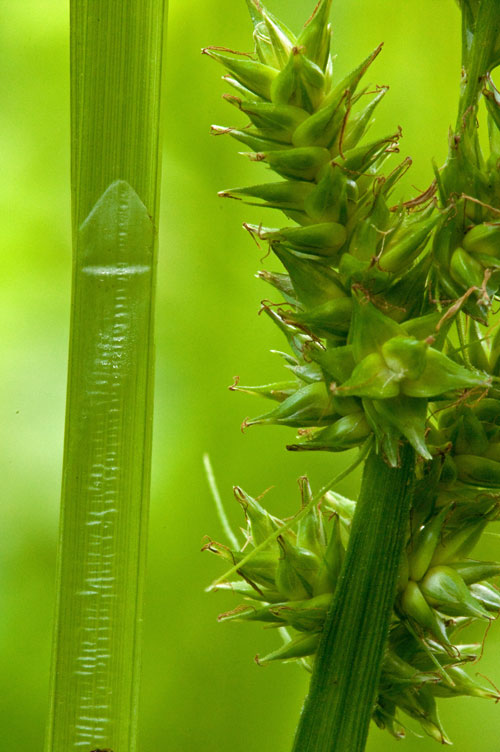 Carex conjuncta at Deep Woods. Hocking County,. Ohio. May 31, 2010. There are some lovely native
wildflowers in the woods. Wild garlic, Allium canadense (Liliaceae, the
lily family) is a common and widespread species of moist soil on
roadsides and woodland paths. It has flat leaves and an umbel
consisting mostly of sessile bulblets, with a very few long-stalked
pink flowers
mixed in. E. Lucy Braun in "The Monocotyledonae" (...of Ohio; OSU
Press,
1967) tells us that capsules are rarely develped, and reproduction is
almost entirely from the bulblets.
 Wild garlic at Deep Woods. May 31, 2010. Meehan's mint, Meehania cordata (Lamiaceae, the
mint family) is a low-growing herb of deep woods. It's the only species
in its genus, and moreover has a narrowly restricted distribution,
confined to fewer than a dozen American states --the mid-Atlantic
coastal ones, extending west only to KY and IL. It seems to be a top
seller of native plant nurseries, as it does well in shaded garden
spots.
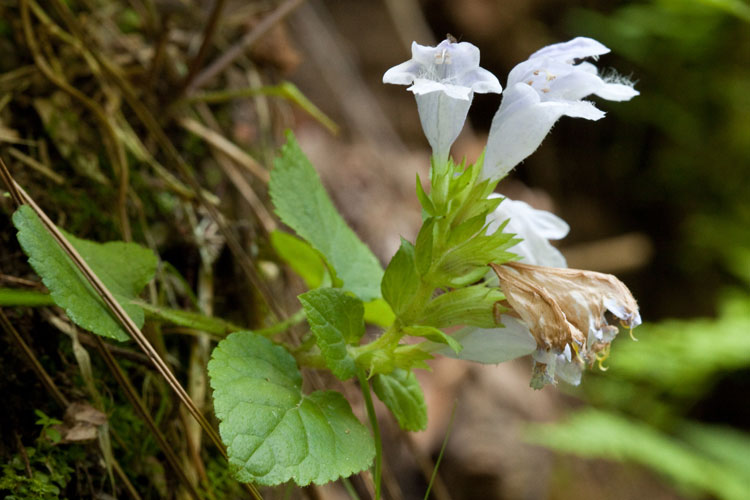 Meehania cordata at Deep Woods preserve. Hocking County, Ohio. May 31, 2010. On the way home I stopped by a friend's house to snap pics in a meadow packed with a small variety of introduced grasses and wildflowers. 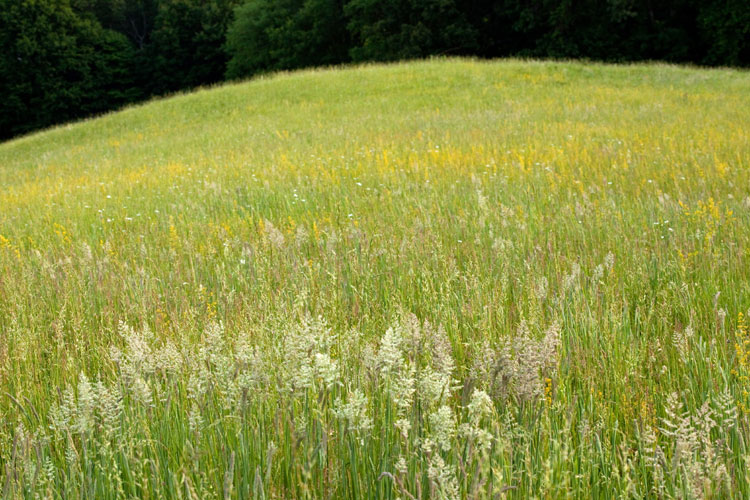 Grassy meadow in Hocking County, Ohio. May 31, 2010. One of the grasses (not the
dominant one, which is tall fescue) is velvet-grass, Holcus lanatum (Poaceae, the grass
family).
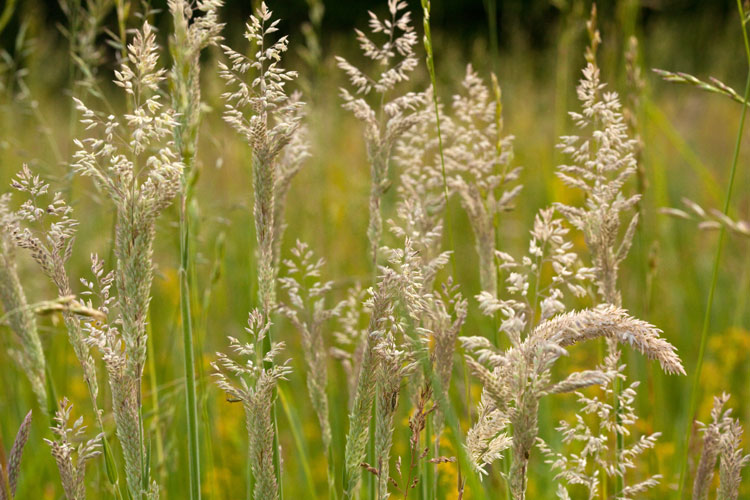 Velvet-grass in a pasture in Hocking County, Ohio. May 31, 2010. Suffusing the meadow with a
delightful golden yellow is yellow bedstraw, Galium verum (Rubiaceae, the madder
family ...what is the Rubiaceae mad about I wonder?). This is native to
Europe and
Asia. Bedstraws were once used to stuff matresses because their aroma,
now attributed to the chemical coumarin, kills or repels fleas.
 Yellow bedstraw. Hocking County, Ohio. May 31, 2010. Our friend Sandi across the
street, whose house is flanked by two magnificent American sycamore
trees (Platanus occidentalis, fam. Platanaceae), was lightly trimming
one of them because a branch was rubbing against her roof. With puzzled
excitement, she showed me this branch. Apparently the lower secondary
branch extended horizontally alongside the one it originated from, then
eventually came to rub against the main branch, and finally fused with
it.
 A botanical oddity? American sycamore branch grafted with itself. Columbus, Ohio. May 30, 2010. Cucumber-root is
Pollinated, Maybe
Deep Woods Preserve Hocking County, Ohio. May 23, 2010 Is was a great pleasure
tagging along on another OSU "Local Flora" class field trip to Deep
Woods Preserve, a privately owned nature sanctuary in Hocking County,
Ohio. There is a fire pit there, full of ashes from a recent campfire,
where several large butterflies alighted to sip mineral salts in a
congregation similar to "puddle clubs" that are known to form on muddy
soil in damp areas. A tiger swallowtail is in the background. This is a
primarily forest species that also occurs in parks, gardens, and
meadows. Its host plants are a variety of trees, including ash,
tulip-tree, sassafras, and black cherry. The foreground critter is a
spicebush swallowtail, also most prevalent in forests, as its host
plants are members of the laurel family (Lauraceae) -- sassafras and
spicebush. It is believed to be a pipevine swallowtail mimic, protected
from predators by its close resemblance to that species, which
sequesters toxins from its host plants.
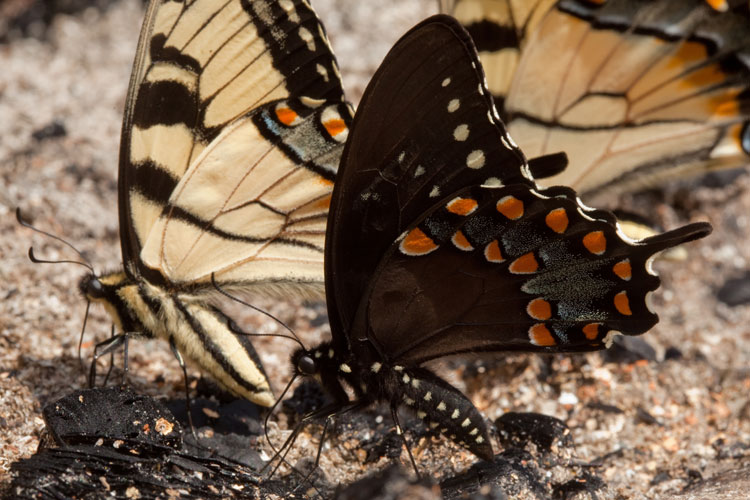 Tiger, and spicebush, swallowtails at Deep Woods. May 23, 2010. Gracing a meadow we crossed on the way to the deeper woods, is a lovely native wildflower in the lettuce subfamily (Cichorioideae) of the aster family (Asteraceae). This is two-flowered Cynthia, Krigia biflora, recognized by its deep orange-yellow flowers and (not shown here) clasping upper leaves.  Two-flowered Cynthia at Deep Woods. May 23, 2010. Deep in the woods a
wind-thrown tree is covered with a common acrocarpous (i.e., "cushion
moss," having upright stems bearing sporophytes at the tips)
moss, Plagiomnium cuspidatum
(Mniaceae). As with all bryophytes (mosses, liverworts, and hornworts),
the gametophytes, which are leafy in the case of mosses and many
liverworts, predominate. Note there are also two sporophyte
individuals. These are indeed separate plants, although each is fixed
to --actually parasitic upon --
the maternal gametophyte that produced it.
 The moss Plagiomnium cuspidatum at Deep Woods. May 23, 2010. Also observing the moss is a
snail. I don't know for sure, but I think it may be a white-lipped
forest snail, Triodopsis albolabris.
Suggestions, anyone?
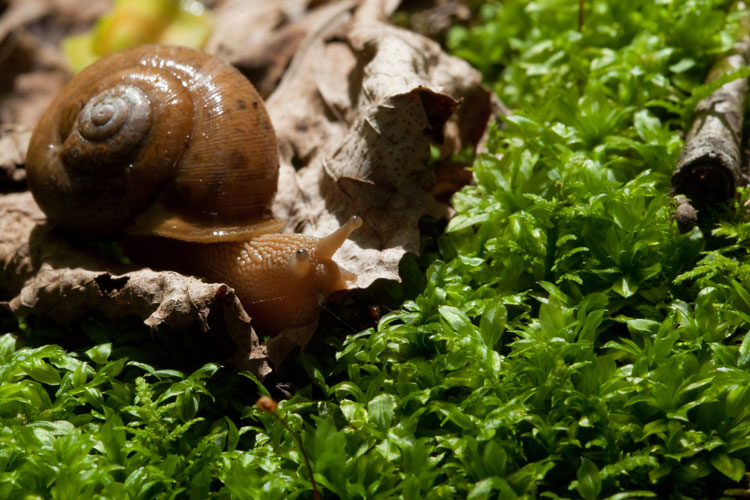 Snail approaching moss at Deep Woods. May 23, 2010. A marvelous plant is American
cancer-root, squawroot, or bear-corn Conopholis
americana (Orobancaceae), a plant that lacks chlorophyll and
lives as a parasite on the roots of forest trees, primarily oaks and
beech.
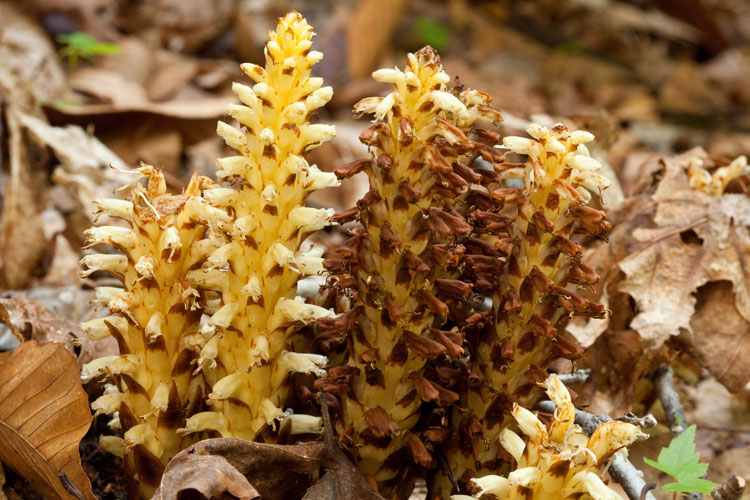 Conopholis americana at Deep Woods. May 23, 2010. Indian cucumber-root, Medeola virginica
(Liliaceae) is a perennial forest herb that produces whorls of leaves
in a delightful two-tiered growth form. Sterile (vegetative) stems
produce just one large whorl of leaves, while flowering ones extend
farther
and add a smaller whorl, plus flowers nodding below its leaves.
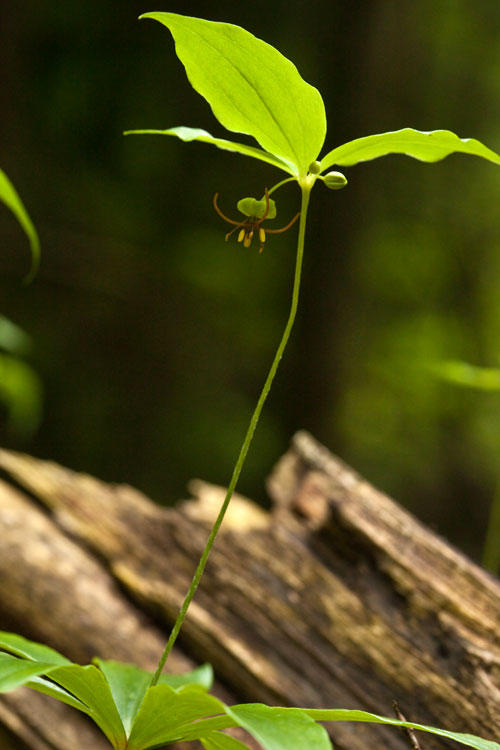 Indian cucumber-root at Deep Woods. May 23, 2010. The flowers of Medeola,
in typical lily family fashion, have a perianth consisting of 6 similar
parts --sepals and petals, thus called "tepals" --that are recurved.
The stamens are 6 in number. The ovary is globular, and attached to it
are 3 styles
united only at their base. The styles are widely divergent and
recurved, extending
beyond the tepals.
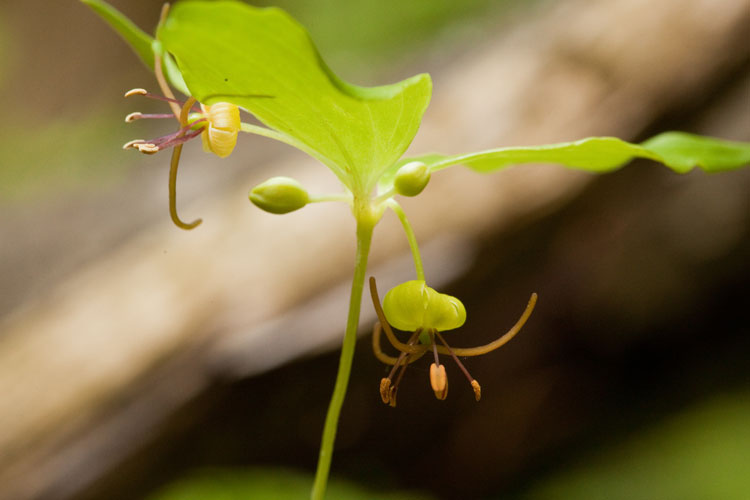 Medeola virginica at Deep Woods. May 23, 2010. While
I was photographing
this plant, and thanking natural selection for human ingenuity that
resulted in a camera having sufficient light
sensitivity (ISO 3200) to take such pictures in a shady forest
environment (to say nothing of the shady forest environment itself), a
"pollen bee" (i.e., one of many native solitary bees that gather mainly
pollen for her young, and does not sequester large amounts of honey)
arrived. Notice that she lands on, and grabs onto, a long
recurved style-branch.
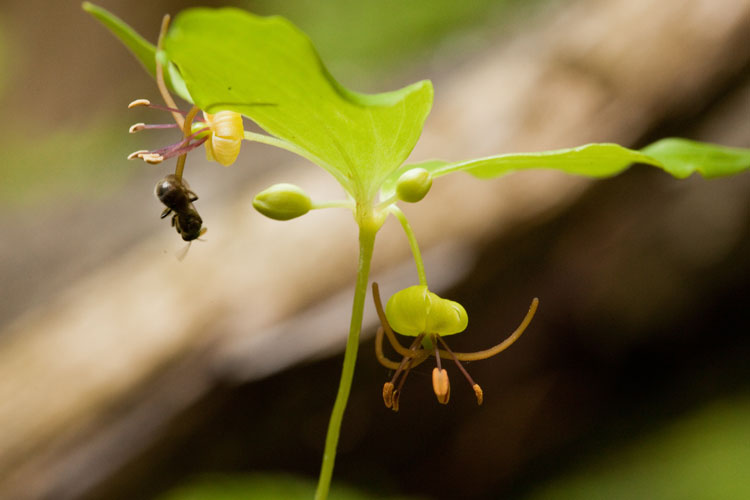 Medeola with incoming bee at Deep Woods. May 23, 2010. She clambers about a bit,
trying to gain a foothold. This is a pollen-gathering bee. Note that
the stamens on the flower she landed on are old and mainly depleted of
pollen. Perhaps she noticed that, too, and is looking farther afield.
 Medeola with clambering bee at Deep
Woods. May 23, 2010.
The bee's next stop is the
other flower. Again, she uses a style-branch as a landing post.
 Medeola with bee landing a second time. May 23, 2010. Deep Woods, Hocking County, Ohio. Intrigued by the opulent
anthers nearby, she hops over to them, and begins collecting pollen.
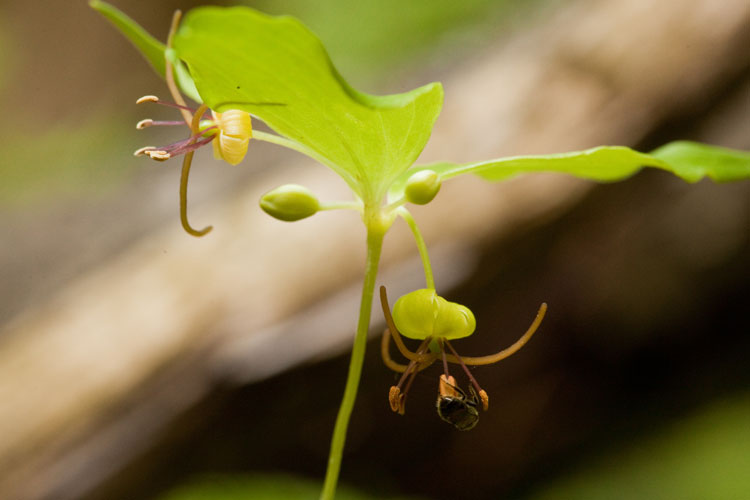 Bee gathers pollen from Medeola at Deep Woods. May 23, 2010. Depending upon the species,
pollen bee females construct nests underground or in small holes in
wood or in hollow twigs. Being solitary, each will typically attempt to
raise approximately ten offspring in separate cells provisioned with
"bee bread," a mixture of pollen, nectar, and perhaps other glandular
secretions and plant oils.
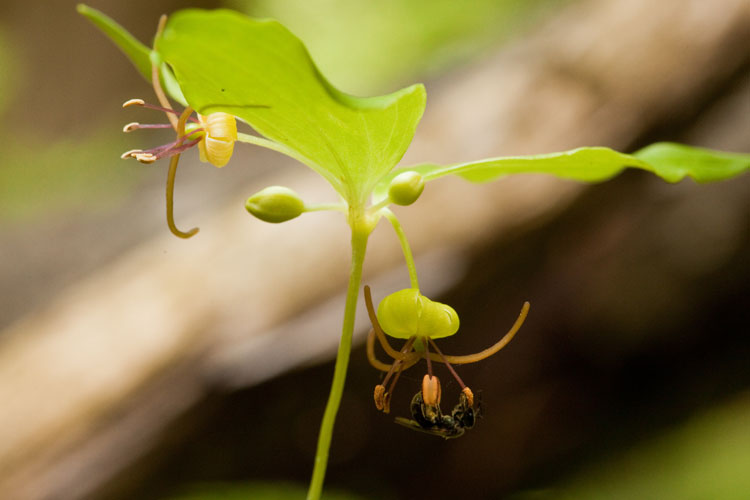 Bee gathers more pollen from Medeola at Deep Woods. May 23, 2010. About the time I got my
camera set up to shoot video, the bee zipped away, laughing.
 Medeola after the bee went away. May 23, 2010. Deep Woods Preserve. Here's a side-by-side
comparison of "actual pixels" views of the style branch the
bee first landed on before, and after, that momentous event. I'm
trying to convince myself that the pollen grains evident on the
right-hand ("after") picture were absent earlier, and moreover that
this constituted sufficient pollen deposition to effect plant
parenthood. This may be true, because the cucumber root fruit is a
few-seeded berry, and each seed
develops from just one fertilization event (i.e., one pollen grain's
extension and subsequent entry into the ovule).
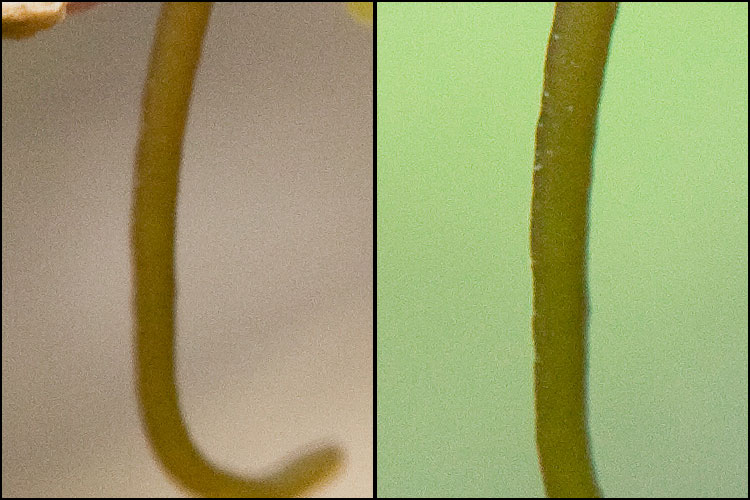 Medeola style. Left: before bee landing. Right: after bee landing. May 23, 2010. At the edge of the woods near
a creeek, a large old eastern hemlock tree is adorned with a lichen.
One is accustomed to seeing foliose (leafy) lichens on tree bark, but
closer examination reveled this to be a fruticose (shrubby) type --a Cladonia.
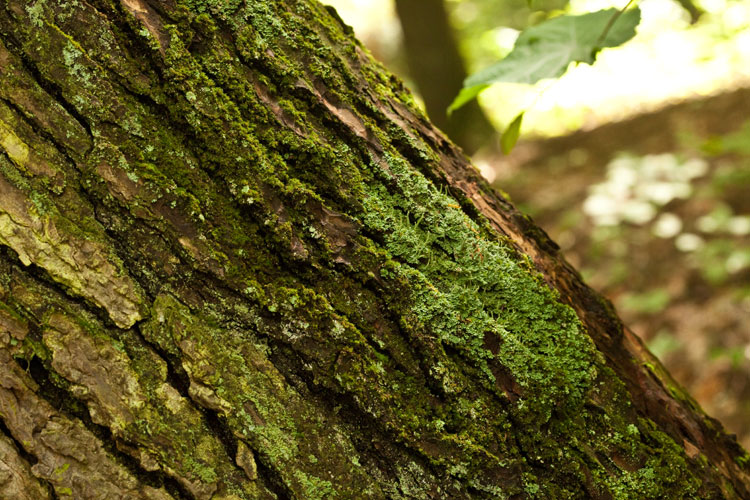 Eastern hemlock bark adorned with Cladonia lichen. May 23, 2010. It's even better, as the
lichen is not only producing upright podetia, but some of the podetia
are tipped with bright red apothecia. They're tiny to be sure, but
apothecia nonetheless. Several feature of this lichen, including the
presence of soredia (minute spherical bodies --algae enclosed by hyphal
threads --that have the capacity to develop into a new lichen) and its
positive reaction to a simple chemical test (quickly turning deep
yellow when dabbed with a solution of potassium hydroxide, KOH),
revealed this to be the lipstick powderhron, Cladonia macilenta.
Showman and Flenniken (2004) in "Macrolichens of Ohio" tell us "This
widespread US species is common on bark, old wood and soil; scattered
and fairly common in Ohio; on bark, occassionally on soil. This species
was formerly called C. bacillaris."
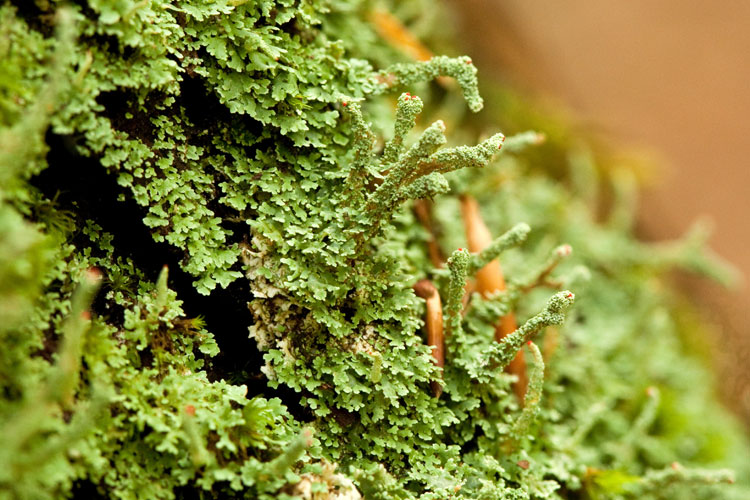 Cladonia macilenta. Deep Woods,
Hocking County, Ohio. May 23, 2010.
Ohio Heritage
Naturalists Foray
Sedges and Lichens at the Pfiefer Tract Jackson County, Ohio. May 22, 2010 Ohio is the
greatest state for "citizen science." A case in point: every Spring and
Summer several "Ohio Heritage Naturalist" (OHN) field trips, organized
by ODNR's Ohio Heritage Botanist Rick Gardner, explore selected prime
natural areas in search of their unique biota. The OHN field trippers
seems mainly, but not exclusively, interested in plants and lichens. I
had the pleasure of going on an OHN trip to a lovely tract in Jackson
County owned by a delightfully generous and hospitable couple, the
Pfiefers. This is a quality woods and reverting dry fields that have
some post oak openings, and a small stream and wet areas near the
stream.
The wet ares near the stream consist of dense stands of a magnificent small tree that that is well known as an ornamental, a joy to see in its native environment, river birch, Betula nigra (Corylaceae). Uncommon in Ohio, and occurring naturaly only in a several southern counties, river birch is the most southerly occuring of all North American birches. 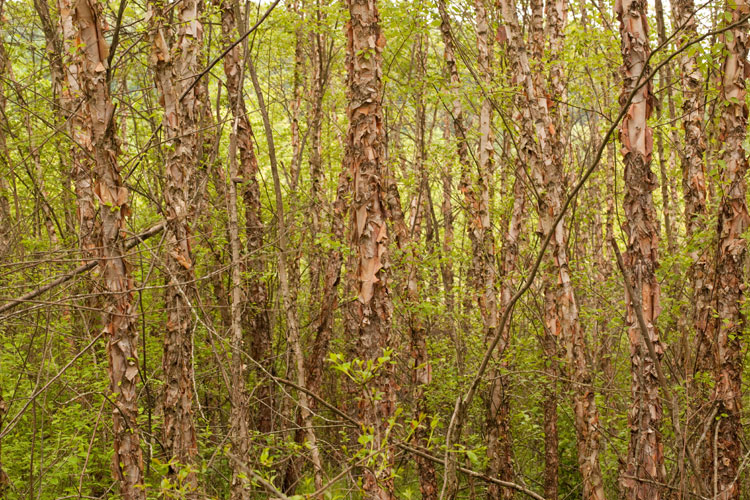 Dense stand of river birch. Jackson County, Ohio. May 22, 2010. It's no wonder river birch is
a prized ornamental. It has beautiful exfoliating bark.
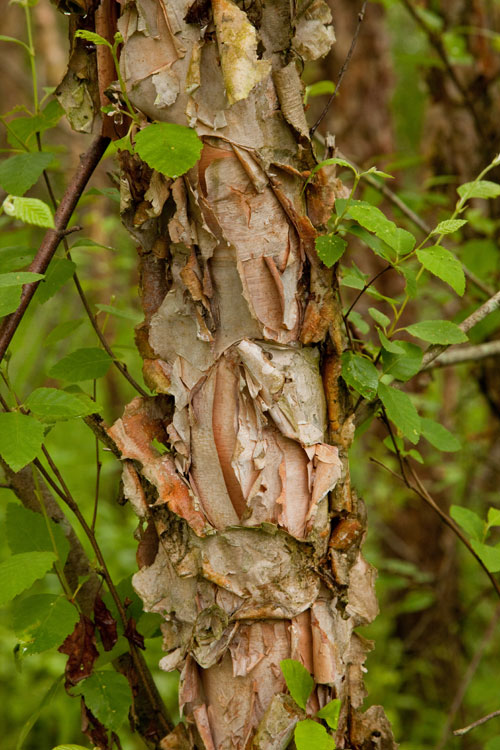 Bark of river birch. May 22, 2010. Jackson County, Ohio. Another tree of southern
affinity near its nothern limit in Ohio is post oak, Quercus stellata.
Post oak attains only shrub stature under the sandy or clayey
poor-soil conditions it typically grows in, but it can grow into a
medium sized tree under better conditions. The common name relates to
its use as fence posts, while the specific epithet stellata, meaning "starlike,"
refers to the Maltese Cross leaf shape.
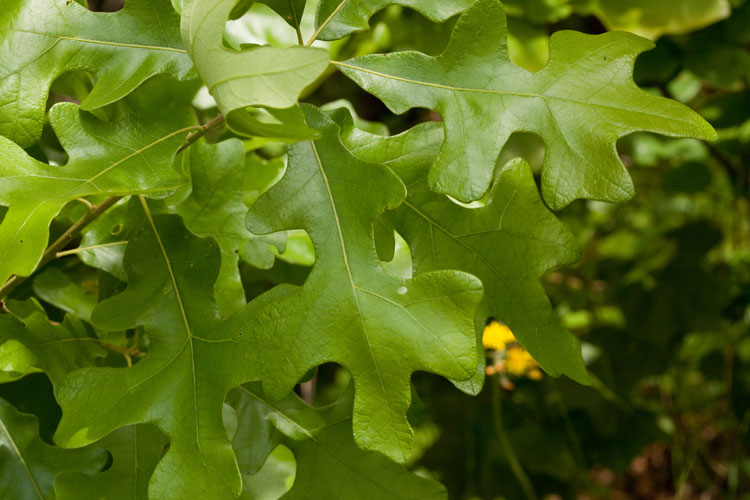 Post oak. May 22, 2010. Jackson County, Ohio. The meadow is also home to a
colorful little member of the Iris family (Iridaceae), a monocot family
characterized in part by having two-ranked leaves that are "equitant"
(with bases astride one another, or astride stem, like the legs of the
rider of a horse, i.e., an equestrian), flowers subtended by
spathe-like bracts. This is narrow-leaved blue-eyed-grass, Sisyrinchium angustifolium. Note
the epigynous (inferior ovary) flower type, wherein the overy (seen as
the swollen portion) is located beneath
all the other flower parts.
 Blue-eyed-grass. May 22, 2010. Jackson County, Ohio. The Ohio Heritage Naturalists
seems to have sedge-dar (sedge radar), so going on an OHN foray is a
great way to learn some sedges. I snapped pics of a few of the many
sedges we saw. One of them is bottlebrush sedge, Carex lurida, in sect. Vesicariae.
This is an abundant, variable and often weedy species of wet meadows,
marshes, seeps, shores, swamp forests, etc., found mostly in acid soils.
 Bottlebrush sedge in wet meadow. May 22, 2010. Jackson County, Ohio. Carolina sedge, Carex caroliniana, sect.
Virescentes, is a denizen of ditches and shores (and apparently also
wet meadows) that has a terminal spike staminate at base, and mature
perigynia nearly circular in cross-section.
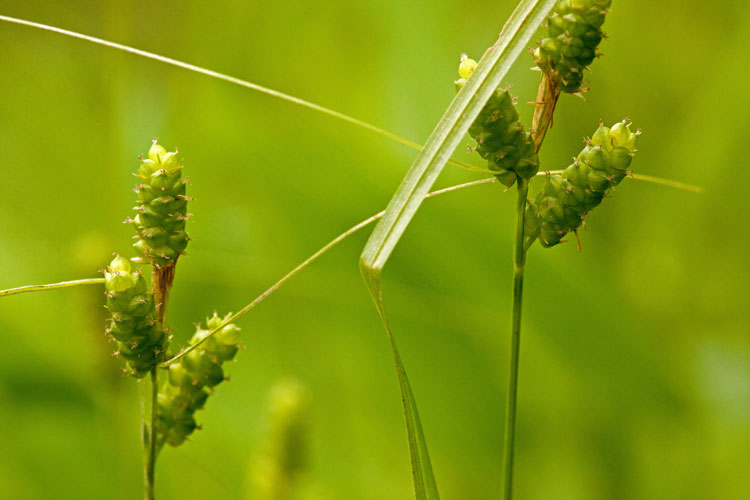 Carolina sedge in wet meadow. Jackson County, Ohio. May 22, 2010. Squarrose sedge, Carex squarrosa, sect. Squarrosae,
is an inhabitant of wet woods, forest edges and meadows.
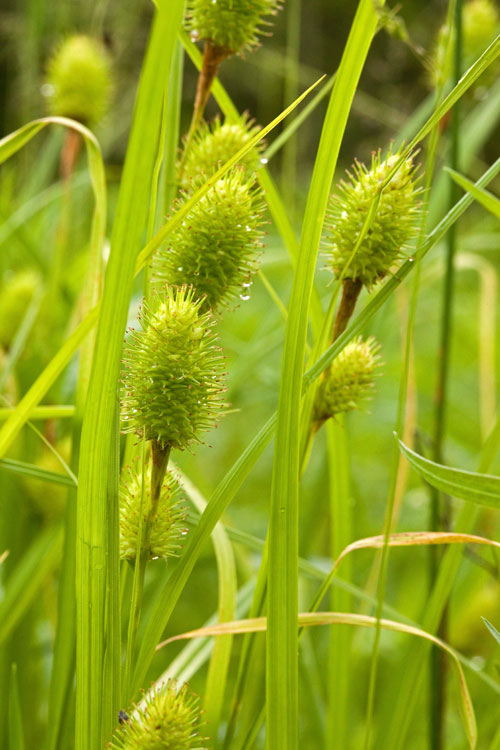 Squarrose sedge. May 22, 2010. Jackson County, Ohio. Reflexed sedge, Carex retroflexa, sect. Phaestoglochin (formerly Bracteosae) dwells in thickets and openings in dry deciduous forests. It is a smooth-beaked member of a group with many rough-beaked species, and is further distinguished by having perigynia that are spreading to reflexed when mature. (A coastal plain/Ozark species, C. texana, that has been introduced into Ohio is sometime confused with C. retroflexa. The perigynia are wider on C. retroflexa.) 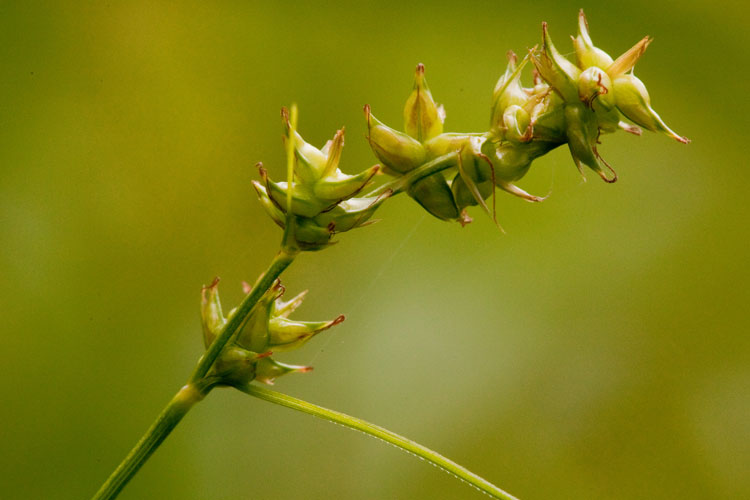 Reflexed sedge. May 22, 2010. Jackson County, Ohio. There are some beautiful
lichens at the Pfiefer tract, including several members of that
wonderful exemplar of fruticosity (shrubbyness), the genus Cladonia, represented by about 45
species in Ohio. Here's the best known North American Cladonia, the famous "British
soldiers," C. cristatella,
distinguished by its small stout tall upright extensions ("podetia")
tipped by swollen bright red spore-producing apothecia.
Accompanying the soldiers is a small scrap of dixie reindeer lichen, Cladonia subtenuis.
The reindeer lichens are distinguished by their densely tangled growth
form and the absence of the foliose-like primary thallus often
seen at the base of other Cladonia
lichens. Reindeer lichens, long considered part of Cladonia, were for a few years
placed in a separate genus "Cladina,"
but now a modern analysis has restored them to Cladonia. Welcome back, reindeer
dudes!
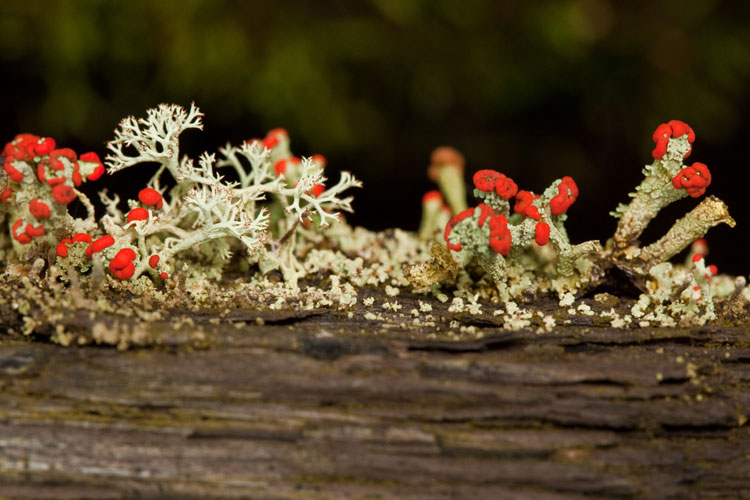 Two Cladonia species: British soldiers, and reindeer, lichens. May 22, 2010. Jackson County, Ohio. Another striking and
distinctive Cladonia is
Turban lichen, C. pezizaformis.
Turban lichen, according to Ray Showman and Don Flenniken in their
"Macrolichens of Ohio" (2004, Ohio Biological Survey) is distinguished
by having "very short squamules; twisted and contorted podetia;
turbanlike pale brown apothecia," and is a "common species in the
eastern U.S., widespread in Ohio, one of the commonest of the
brown-fruited Cladonia spp.,
a frequent "old field" species; on soil, occasionally on bark or over
rock.
 Turban lichen. May 22, 2010. Jackson County, Ohio. The "Cladonia pyxidata
complex" is a group of five confusingly similar cup-forming species,
separated from one another based on technical charachters I
haven't mastered yet. This one is growing on the ground of an open
hillside.
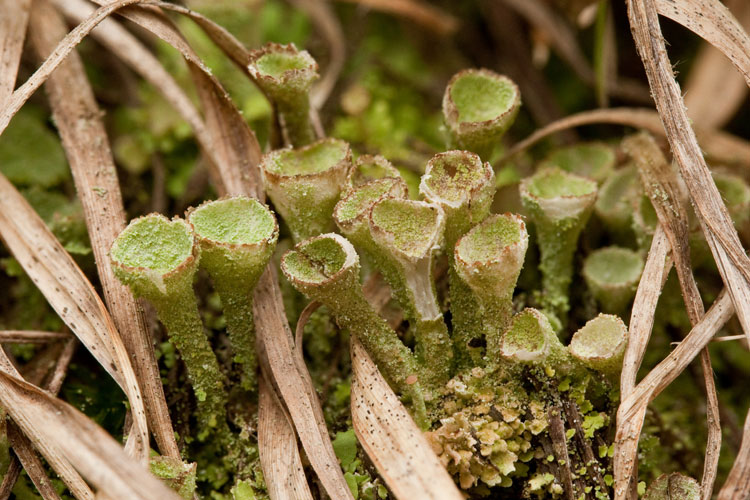 Cup-forming Cladonia. May 22, 2010. Jackson County, Ohio. Growing alongside the
pyxie-cups is a lush clump of dixie reindeer lichen, Cladonia subtenuis.
This, the most common of the 3 species occuring in Ohio, is
distinguished by its yellow-green (not ashy-white) color, and podetial
tips mainly branching in twos (not threes).
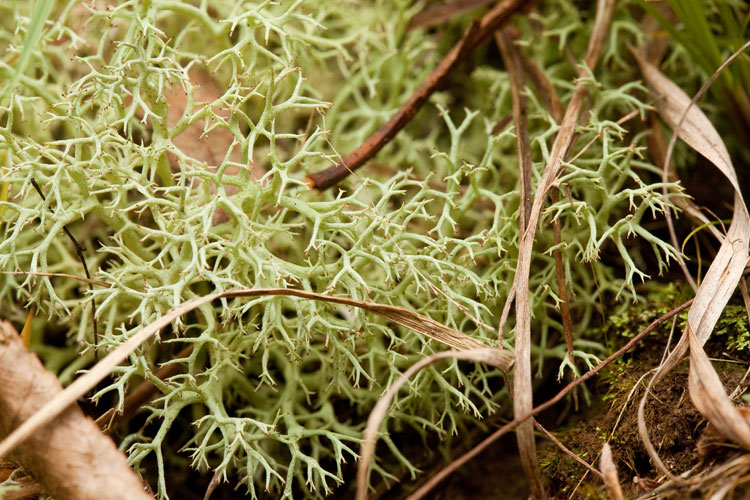 Dixie reindeer lichen. May 22, 2010. Jackson County, Ohio. It is a great pleasure to see
a little tuft of bushy beard lichen, Usnea
strigosa.
The beard lichens are quite pollution-sensitive and while thus limited
in distribution, are making something of a comeback. Nine species have
been recorded from Ohio; this is the most commen (least rare). Older
specimens may bear abundant apothecia.
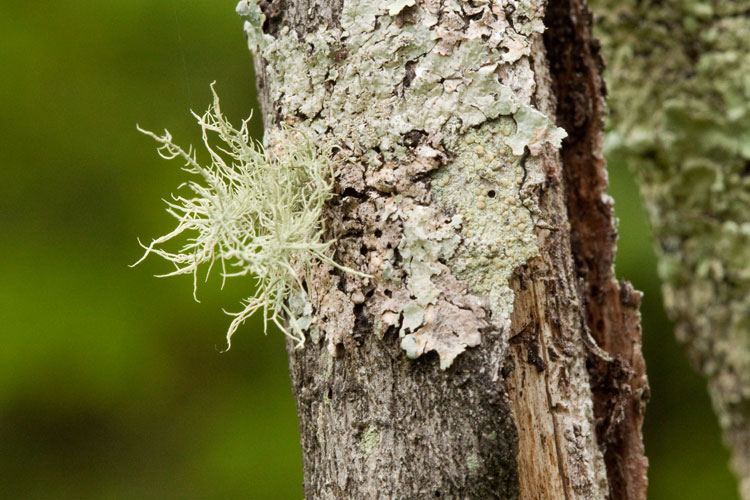 Bushy beard lichen. May 22,
2010. Jackson County, Ohio.
Older
specimens may of bushy beard lichen bear abundant apothecia. Recently a
friend brought me back this amazing apothecia-bearing Usnea specimen from South Carolina.
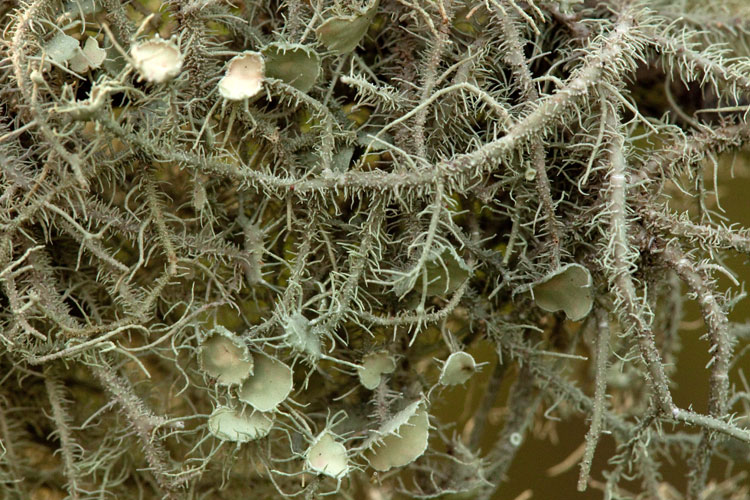 Apothecia-bearing beard
lichen specimen from South Carolina.
A widespread foliose (leafy)
lichen found on trees (in this case a fallen log) is common greenshield
lichen, Flavoparmelia caperata.
Greenshield lichen is characterized by having a yellow-green thallus
with rather broad lobes.
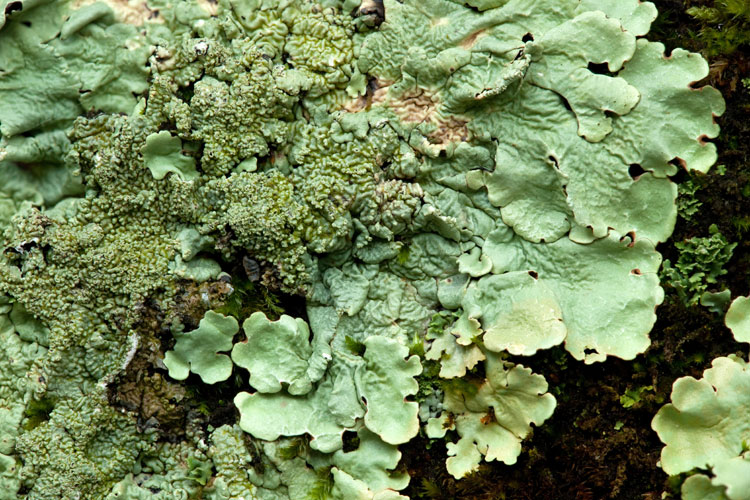 Common greenshield lichen. May 22, 2010. Jackson County, Ohio. Southern adder's-tongue, Ophioglossum vulgatum
(Ophioglossaceae) is an uncommon, but not rare, fern that is easily
overlooked owing to its small size and superficial similarity to some
sort of a monocot seedling. Seen here in the forest, and with grateful
appreciation of Canon for manufacturing a camera that takes pretty good
pics at ISO 3200, the adder's-tongue stem bears a single leaf, divided
into a vegetative blade-like lower portion, from which extends an
elongate spore-bearing portion. Members of the adder's-tongue family
have remarkably big sporangia, and the chomosome numbers of Ophioglossum
are the highest known of all vascular plants, in some species exceeding
1200! (That's an exclamation point after the number 1200, not a
"factorial" sign, but it's still a heck of a lot of chromosomes!)
 Adder's tongue fern bears a single leaf divided into a lower, vegetative portion, and an upper, sporagium-bearking portion. |
|
 |
|
 |
|